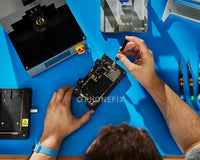If you’ve ever wondered why Tesla’s minimalist dashboard feels both intuitive and powerful, look no further than the front control panel. This unassuming assembly combining the Front Body Controller (FBC) and central touchscreen. The front control panel of the Tesla Model 3 is the nerve center of its low-voltage electrical system. Unlike traditional cars relying on fuses and relays, Tesla’s innovative power supply design redefines reliability and efficiency. 
While Tesla hasn’t released official schematics, teardowns and circuit analyses reveal a four-stage architecture.
1. Input Stage: 12V Battery Interface.
Primary source directly connects to the 12V AGM battery in the front trunk, with dual parallel ground links to the electric power steering system for redundancy. Features a reverse voltage protection diode and a fusible inductor to block backflow and cut off short-circuit currents .
2. Conversion Stage: DC-DC & Isolation Modules.
Driven by the LMR14020 new energy IC, it steps 12V down to 5V for low-power components. Powered by TI’s UCC28730-Q1, it provides isolated 12V for high-sensitivity modules with three windings for feedback and dual outputs .
3. Distribution Network: Smart Power Routing.
Supplies power to left/right body controllers and replaces fuses with High-Side Driver chips and eFuses, controlled by an MCU to switch 60+ loads.
4. Protection & Monitoring Layer.
EFuses trigger software-defined shutdowns within microseconds. HSD chips monitor voltage/current anomalies and report to the central MCU.
Core Roles: Beyond Simple Power Delivery.
1. The "Power Hub" of Vehicle Electronics.
It acts as the primary distribution center, feeds power to critical systems, such as Autopilot ECUs, touchscreen, and airbag controllers. And enables secondary distribution via VC Left/Right to door locks, window motors, and seat heaters .
2. Software-Defined Power Management.
Tesla’s elimination of mechanical relays enables dynamic control. For example, cuts power to non-essential modules after 30 minutes in Park to save battery.
3. Redundancy for Safety.
Honeycomb casing protects circuits, ensuring airbag controller power during impacts. Parallel ground and power links prevent single-point failures .
Key Functions in Daily Use.
1. Critical Component Power Supply.
5V DC-DC converter powers the main touchscreen, with a dedicated reboot circuit for unresponsive displays. USB-C Ports delivers up to 65W to rear ports, with power only active when the vehicle is awake.
2. Dynamic Load Regulation.
LMR14020 SS pin capacitor prevents voltage spikes when powering up the touchscreen. And 12V outlet in the center console supports 12A continuous draw for accessories.
3. Fault Detection & Recovery.
Fusible inductor FB17968 within milliseconds if the 5V circuit shorts. HSD chips trigger dash warnings for open/short circuits.
Tesla’s VC Front exemplifies the shift to zonal architecture. Eliminating 50+ mechanical fuses. Software updates can reconfigure eFuse parameters. And field data shows 80% fewer power-related failures than traditional systems.
The front control panel’s power supply isn’t just wires and chips, it’s Tesla’s blueprint for automotive electrical innovation. Its dual role in basic safety and user experience means even minor damage demands urgent attention. For owners, staying vigilant about updates and warning signs isn’t just about convenience, it’s about survival.
Tesla Model 3 Front Control Panel Power Supply Architecture & Its Critical Roles










